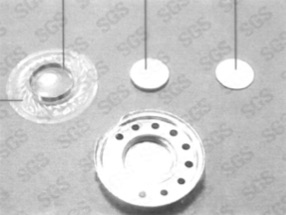Taking Apart a SleepPhones Headphone Speaker
Neodymium (Nd2Fe14B) magnets consist of Neodymium, Iron, and Boron. They are very powerful magnets so just a small piece of it can produce more force than a traditional ferrite magnet of the same size. Headphone speakers use them because a small piece can be enough to drive a flexible diaphragm to produce sound. Here's a picture of one of our older version speakers taken apart.
The different parts of our speakers: wax paper (covers adhesive on screen) — screen — metal screen — mylar (damaged from rough procedure) — copper coil — back plate with neodymium magnet in center (couldn't get magnet out) — back screen — coil solder points

Here's how a speaker works:
The tiny electrical impulses are conducted through the cord (not pictured) to the solder points
The impulses conduct through the copper coil (2), generating a magnetic field. The magnetic field that the coil produces attracts and repels against the neodymium magnet (4) in the back of the speaker enclosure. With the coil moving toward and away from the magnet as current pass through it, it pulls the attached mylar film (3) with it. The mylar film (3) is like the diaphragm of a drum, making sound as it moves air. The small holes in the metal (5,6) are openings for the sound waves to pass through the air to your ears. The dust screens (7,8) just keep dust out of the delicate mechanism.
The magnet is shown here in a picture from SGS, our RoHS testing company. They managed to pry out the magnet, which is the top center piece. In RoHS testing, they ran every single part (including our wires and fabrics) through to look for Cadmium, Lead, Mercury, Hexavalent Chromium, PBBs, and PBDEs. We passed with flying colors!

A customer recently asked about the safety of the magnetic fields. The magnetic fields generated by magnet and the coil are actually really tiny. Compared with large over-the-head headphones, our magnets are much smaller and less powerful. Compared with in-ear earbuds, our magnets are much further away from the brain, since they sit outside of the ear, separated by a few layers of fabric. The magnetic fields are simply to drive the mylar film to move, so they don't need to be very powerful at all. Neodymium is a rare earth metal, which is fairly expensive. We use as little as possible, to preserve it and to keep costs low. We optimize every other aspect of the speaker's design to make sure the magnetic forces are used as efficiently as possible.
We don't have a sophisticated device to measure the magnetic force of our headphone speakers in terms of teslas (T). But we can demonstrate the amount of force in this video.
According to the World Health Organization, there are few studies about the impact of static electromagnetic fields, especially long-term. Most studies are about giant, powerful magnets like in an MRI machine or certain manufacturing processes. However, keep in mind that the Earth is a giant static magnet too. Earth measures 25-65 microteslas. I found this chart of magnetic fields very interesting. Did you know it takes 16T to levitate a frog?

